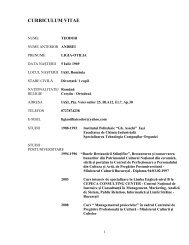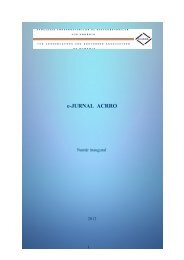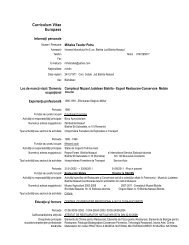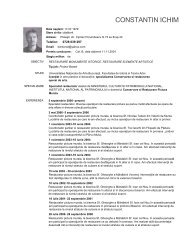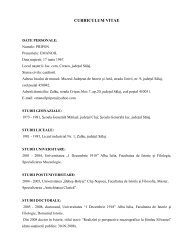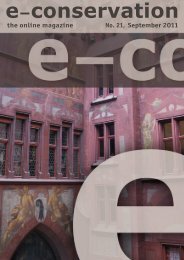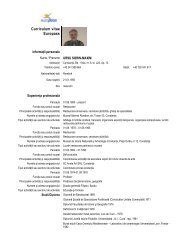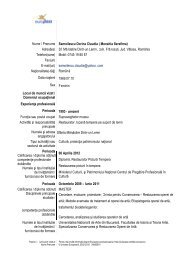e-conservation the online Magazine 16, oct 2010.pdf
e-conservation the online Magazine 16, oct 2010.pdf
e-conservation the online Magazine 16, oct 2010.pdf
Create successful ePaper yourself
Turn your PDF publications into a flip-book with our unique Google optimized e-Paper software.
MICROBIAL STUDY OF EGYPTIAN MUMMIES<br />
rence as follows: Chaetomium globosum and Hormodendrum<br />
viride (14.28%) and Alternaria tenuis<br />
and Chaetomella horrida (9.5%). There are many<br />
reports dealing with <strong>the</strong> microbial levels, such as<br />
Abdel-Kareem et al. [21], Cook and Rayner [22],<br />
Darwish and Sahab [23].<br />
Five bacterial species belonging to four genera<br />
were identified and classified as: Halococcus morrhuae<br />
(30.76%), Streptococcus pyogenes (23.07%),<br />
Micrococcus Kristinae, Micrococcus cinereus and<br />
Halobacterium pharaonis (15.38%).<br />
Effect of some mummification materials on<br />
visual fungal growth<br />
The data in Table 2 shows that <strong>the</strong> mummification<br />
materials have different ability to inhibit <strong>the</strong> mycelial<br />
growth of <strong>the</strong> tested fungal isolates. The<br />
five strains of A. niger, H. viride, P. corylophilum<br />
and A. humicola were very sensitive to natron salt<br />
and relatively sensitive to a Cinnnamomum camphora<br />
extract (figure 3). The natron salts had a<br />
large effect on <strong>the</strong> growth of <strong>the</strong> fungal isolates<br />
because it inhibited <strong>the</strong> fungal growth on a large<br />
area, as <strong>the</strong> NaCl present in natron salt is an historic<br />
preservation material. On <strong>the</strong> o<strong>the</strong>r hand,<br />
<strong>the</strong> same fungal isolates were less affected by<br />
myrrh and beeswax extracts and <strong>the</strong> mummification<br />
materials of Juniperus, Arabic gum and cassia<br />
extracts were found to have no effect on <strong>the</strong> tested<br />
fungal growth.<br />
Enzymatic activity<br />
Enzyme activity of cellulase production in fungal<br />
strains was measured with different substrates<br />
Figure 3. From left to right: Effect of myrrh on <strong>the</strong> growth of Aspergillus humicola, effect of cinnamomium camphora on <strong>the</strong><br />
growth of Aspergillus humicola, and effect of cinnamomium camphora on <strong>the</strong> growth of Aspergillus niger.<br />
Table 2. Effect of some mummification materials on visual fungal growth of some fungal isolates after 15 days.<br />
Fungal species<br />
Aspergillus niger (strain no.)<br />
H. viride P. corylophilum A. humicola<br />
Strain no. 1 2 3 4 5<br />
Natron + + + ++ + + ++ +<br />
Myrrh +++ ++ ++ +++ +++ ++ ++ ++<br />
Juniperus ++++ ++++ ++++ ++++ ++++ ++++ ++++ ++++<br />
Cinnamomum camphora +++ +++ +++ +++ +++ ++++ ++ ++<br />
Arabic gum ++++ ++++ ++++ ++++ ++++ ++++ ++++ ++++<br />
Cassia ++++ ++++ ++++ ++++ ++++ ++++ ++++ ++++<br />
Mistic resin ++++ ++++ ++++ ++++ ++++ +++ ++++ ++++<br />
Beeswax +++ +++ +++ +++ +++ ++ ++ +++<br />
control ++++ ++++ ++++ ++++ ++++ ++++ ++++ ++++<br />
Legend: + (10% fungal growth), ++ (50% fungal growth), +++ (75% fungal growth), ++++ (100 % fungal growth).<br />
e-<strong>conservation</strong><br />
43



